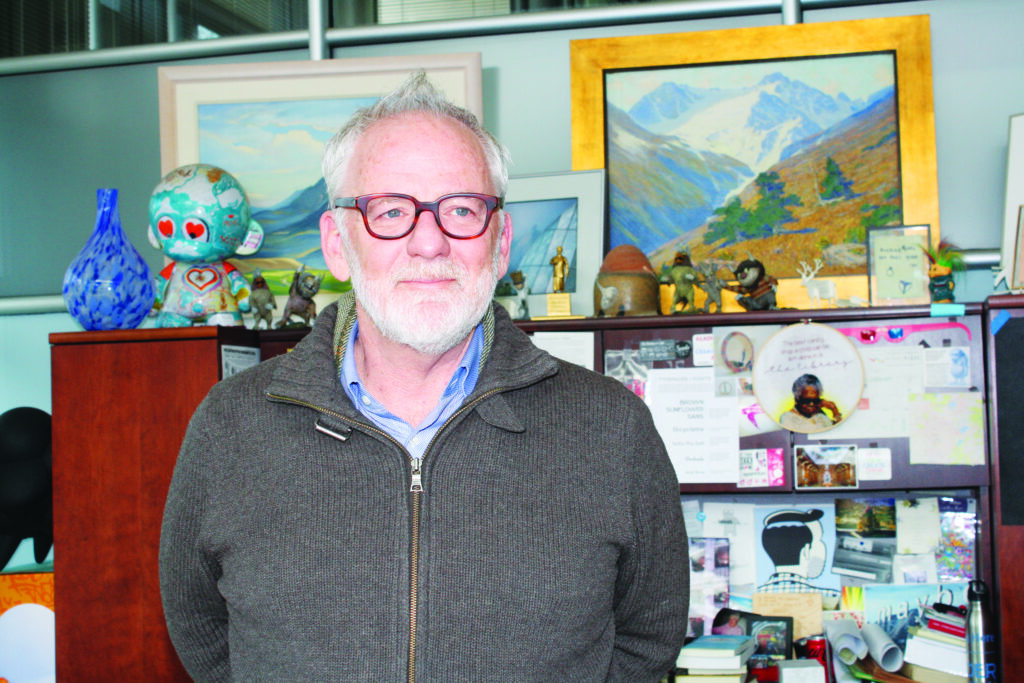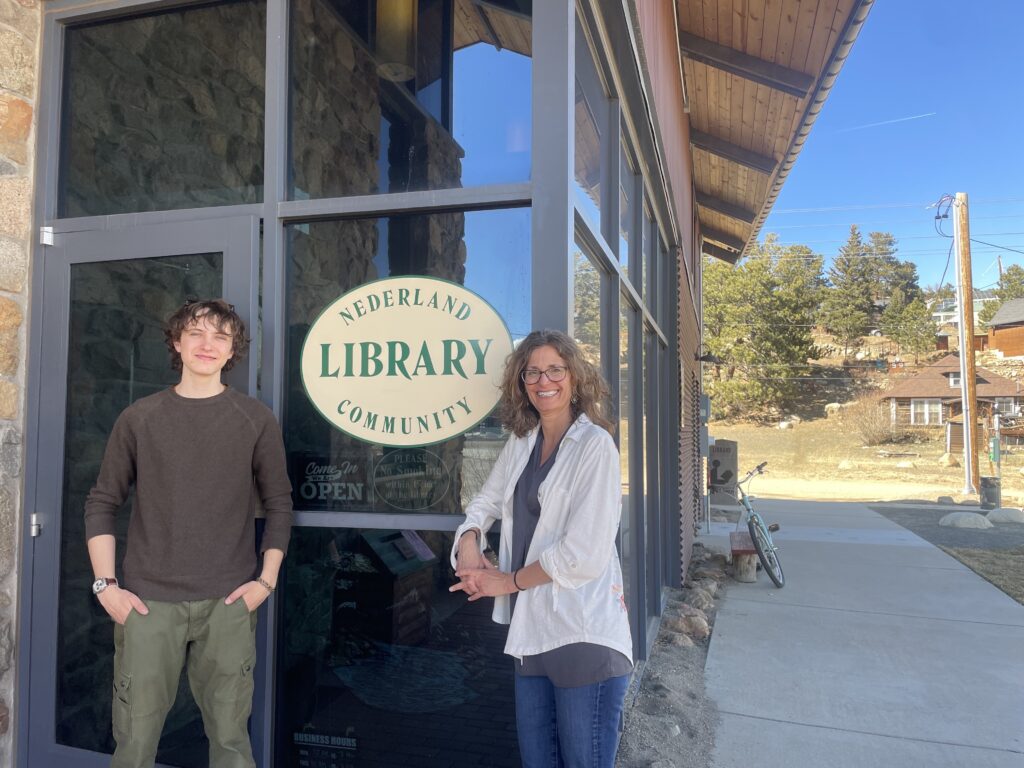
David Farnan still remembers taking laundry down the block in his small, rural Missouri town and coming home with a dozen eggs.
“My mother did laundry, one person had chickens and eggs, another person had an apple and a cherry tree, and we all swapped,” he says from his sunny office on the second floor of the Boulder Public Library. “It was just how poor people in a rural setting took care of each other.”
Today, his work as director of the library runs on that same sort of “economy of sharing.”
“The ethos of the public library, really, is to share. We just share everything,” he says. “The community pays for it, but then we as an institution are tasked with the responsibility of sharing it with everyone.”
For Farnan, that free exchange — of books, of ideas, of space — is “the nexus of building community.” It also makes libraries an anomaly in an increasingly transactional world.
“People ask me all the time, ‘Could you do it? Could you invent the public library today?’” he says. “And I don’t know.”
While the exact origin of the public library is disputed — with Benjamin Franklin and Andrew Carnegie often receiving much of the credit — Farnan says in actuality, it was women of the Progressive Era who championed the cause of public libraries and brought them to fruition.
“They could not vote. They could not own property,” he says. “They’re the ones who came up with this idea about, like, let’s find a way for us to share all of this information with everybody. … Initially, I don’t think it really registered with me how impactful that was that the public library was something invented by people who were disenfranchised.”
Today, the library continues to serve as a beacon of empowerment for the disempowered.
“The library is that safe place,” says Jon Solomon, director of the Longmont Public Library. “If you’re feeling attacked, that’s what we’re here for — to help keep the level of community that exists, but to make it stronger and to be resistant to that eroding, which seems to be happening.”
‘A place to be’
When Farnan asked his staff to come up with the five things that encapsulate their work, the No. 1 item wasn’t books or technology or children’s story times — it was public space.
According to Farnan, an “erosion of public space” has been ongoing for decades.
“There are fewer and fewer things that we think of as public,” he said. “Even 20 years ago, I thought like, there’s a battle for the soul of people, and there is this desire among some elements for us all to just be consumers.”

For Doug Hamilton, president of BPL’s board, libraries are, above all else, a place to be in a space with one another without every interaction being commodified.
“There’s all different types of people,” he says. “It’s an entire cross-section of the community, and you’ll interact with people you may not normally interact with.”
Housed or unhoused, rich or poor, young or old — the library is open to all with well-lit spaces, air conditioning in the summer, heating in the winter and bathrooms that don’t require a purchase to access.
“We’re not going to turn anybody away,” Farnan says. “But then also, more than welcoming them in, they’re included. …We’re free and open to anybody and everybody: angry people, happy people, people of all walks of life.”
Elektra Greer, Nederland Community Library’s director, takes the duty of welcoming seriously. She enthusiastically offers cupcakes and mugs to those signing up for a library card on a spring afternoon and prides herself on the fact that a real human will always answer the library phone — no phone trees or voice assistants.
“Where else can you go where you can sit for hours?” Greer says. “You’re not expected to spend money. You’re not supposed to do anything.”
For Amaya Sanovia, a recent Ned High graduate, the library was just that.
“It’s got me to have a place to be where I don’t have to spend money,” she says. “I can kind of go and hang out.”
Now, she’s gotten more involved as a youth volunteer and has used it to help her transition to her next phase of life.
“I’m going into college this next fall, and through my library, I’ve been able to connect with a lot of resources for scholarships,” she says. “I’m also Native American … so just being able to be in a library community that’s inclusive has definitely been really helpful and encouraging.”
Library of things
Wander into a library and, of course, you’ll see books of all kinds lining the shelves. But look a little closer — or ask a librarian — and you’ll find so much more.
In Nederland, the library has stepped up to be a de facto public information officer in times of natural disaster, according to Greer, with librarians ready to pick up the phone and help distribute information in times of crisis.
“We are part of the instant command structure if there’s emergencies for the community,” she says. “Everyone knows, ‘Oh, the library will be open and has these resources.’” In addition to the Nederland Community Center, the library serves as a potential evacuation site for wildfires or other emergencies.

Ned’s library has also stepped up to fill gaps in the health and human services ecosystem; they’re a hub for dropping off winter coats and serve as a sort of concierge for connecting people to other resources in the community.
They’ve also offered telehealth services since the pandemic and will soon have a soundproof, private pod complete with homecare equipment such as blood pressure cuffs, telehealth equipment with assistive technology for those with hearing or vision loss, and “most importantly, library humans to help our patrons navigate the technology aspects of video conferencing,” Greer wrote in an email in response to follow-up questions.
“Librarians have long nursed the human condition, so telehealth is a great fit!”
Today’s libraries also aim to narrow the digital divide. More than 160,000 households in the state do not have access to adequate internet service, according to 2024 reporting by the Colorado Sun.
In addition to the computers and WiFi offered in the space, some libraries — including Longmont’s — offer hotspots and Chromebooks for checkout.
“It’s hard to imagine what it would feel like to feel so disconnected,” Solomon says. “Just that feeling of being connected and knowing what’s going on and what people are talking about, I think that speaks volumes as far as resiliency and keeping everyone engaged.”

The Lafayette Library offers free tech help to learn to navigate smartphones, the internet and other tech. Beyond the digital, there’s also a host of programs for in-person engagement. Lafayette’s offerings include puzzle competitions, “international tea” and gardening classes.
“It’s kind of a way to get you know community members in the same room working on the same thing,” says Betsey Yadon, a Lafayette enrichment librarian.
They also offer suicide prevention programming and free tax help through AARP.
“We’re supporting our community and giving those types of things to people who might not be able to afford it,” says Zoe Boiarsky, another Lafayette librarian.
Within the “library of things” offered at many libraries, you might find anything from sewing machines to radon detectors to museum passes.
Wander up the stairs at the Longmont Library in the spring and summer and you’ll find a seed library, complete with packets to grow food and flowers in your own backyard. Backpacks at many libraries offer state parks passes through a partnership with the state library.
Visit one of BPL’s makerspaces, a feature that’s become a staple in many libraries, and you can use 3D printers, looms, laser cutters, screen printing equipment and more.
“It’s a collaborative learning environment,” Farnan says. “We’re learning together. If you were to go into the makerspace today and ask, like, ‘I’m thinking about doing this,’ then they would say, ‘I don’t know how to do that, but let’s figure it out.’
“That is inherently resilient.”
He recalls a blind artist who came in with a unique challenge: “She wanted to be able to see her drawings.”
“They worked with her with 3D printers, with the laser cutters and that kind of thing, in order to transfer her drawings into dimensional objects, because they were abstractions, so that she could then see them with her fingers.”
Despite the always expanding array of programming and services, the books themselves — and literacy for all ages — are ever important.

“Read a book, you never know what might happen,” Farnan says. “You might fall in love, you might have an adventure. You might forget all your troubles. You might be terrified. … It’s an amazing thing, for a 500-year-old technology, to still be so instrumental in how we see ourselves and how we can see ourselves change.”
“The act of continual learning is an act of resistance,” Hamilton adds. “Having this strong core of public engagement is what makes the community. We’re only as good as our connections are with each other.”
‘Not gonna sit here and take it’
Today, libraries and the people who run them have increasingly had to fight back against challenges to their core values.
“[Resistance] is not how public libraries necessarily see ourselves, but it’s been something that’s been foisted upon us,” Farnan says.
Back when he became a librarian, he said the core tenets of libraries — being free and open to all, standing up for the First Amendment and resisting censorship in all its forms — seemed pretty simple.
“All of those things have been made extraordinarily controversial, if not incredibly political,” he says.
In 2022, Colorado made up nearly 10% of book challenges in the U.S., according to CPR reporting on American Library Association data. Longmont’s Rainbow Storytime — which features books by and about LGBTQ+ people — faced a petition in 2023.
But Solomon said the answer to calls to end that program, like his answer to requests to remove certain books from the shelves, was simple: It’s staying.
“I’m not gonna sit here and take it,” he says. “We need to be like, ‘No, we are standing up against these things. We are here. We aggressively support our First Amendment rights.’”
In 2024, Colorado passed a law that protects public librarians from retaliation for refusing to remove titles from their shelves and prohibits removing titles based on demographics of the author or “partisan disapproval of the resource.” A similar law pertaining to school libraries and librarians is currently working its way through the legislature.

Not only do libraries stand for the First Amendment, they also defend the right to privacy.
“The number one thing in our profession, our North Star, is privacy and confidentiality of patron records,” Greer says. “People do not know that. Librarians have said, ‘Show me the warrant.’”
“We don’t want to know what you checked out,” Solomon says. “We delete the information intentionally so that no one else can know what you checked out.”
That makes libraries more vital than ever, he says.
“It becomes more and more important that we exist so that people can get information without fear that someone is watching them,” Solomon says. “They can read what they want without fear that someone is looking at what you’re reading and making a decision on that.”
Show up
Just last week, the entire 70-person staff of the Institute of Museum and Library Services, the federal agency that funds libraries and museums across the country, was put on leave. The Colorado State Library receives more than $3 million annually from the IMLS — more than 60% of its budget. Although public libraries are primarily funded locally, many receive grants and other support from the state library, as do school and prison libraries.
Sitting on the patio of the Nederland Community Library listening to the songs of springtime birds and the warble of the creek flowing by, Greer likens libraries to pollination or a life-giving stream. To lose libraries, she says, would be to lose the “social and soulful infrastructure” of society.
When it comes to making sure libraries and the community building they do can continue, Hamilton says “show up and be in community, and keep showing up, because we have a duty to each other to preserve what we have and to build on it.”
“Libraries are the last great unbroken promise of a democratic society,” Farnan says. “This is it. This is the last thing we got. We have not changed the promise, like, everybody’s welcome, anybody can get access to anything, and we’re going to stick up for all those things that make us good.”
